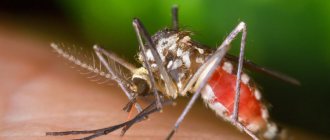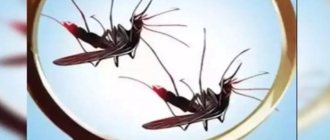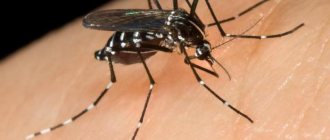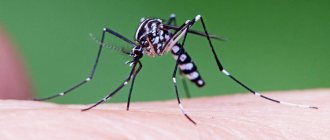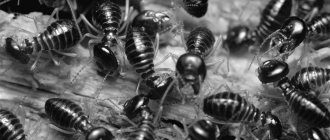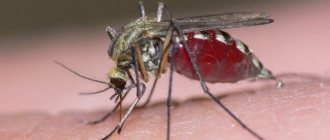Do you know what green mosquitoes are? These small insects are also called chironomids. They belong to the order Diptera. An adult can flap its wings up to 1000 times in 1 second. An adult individual, due to the fact that the oral apparatus is underdeveloped, cannot take food. But the larvae of bells feed on detritus, as well as microorganisms. Their habitat is natural silt. Interestingly, the larva can successfully exist at a depth of 300 meters. Some of them may be predators. Bell mosquitoes do not pose a danger to humans; their offspring serve as food for fish. Their habitats are very extensive; they can be seen near Russian reservoirs in reed thickets or in the northern part of Tunisia, for example.
Life cycle and other features
The ringing mosquito bothers you with its squeaks - this is its key harmfulness
Chironomids are divided into 3000 species. The life cycle of this insect is very short, only 7 days, in some species it is 3 days. Outwardly, they are not very noticeable, colored dark brown or yellowish-green. Why were they called bells? It turns out that males gather in huge flocks and soar in the air, emitting a specific ringing sound to attract a female. The female, having heard their call, following her instincts, flies into a huge flock of males. In just a couple of seconds, she flies out fertilized.
The second name is jerk mosquitoes, they received due to the peculiarity of landing on the surface. These insects rely only on the back and middle pair of legs. The forelimbs are always raised, so the body of the insect is continuously supported. This position of the body is due to the fact that they detect the approach of danger.
Up to 9 mm long, hairy green bells are larger than the common mosquito. Chironomids lay their eggs in mud, and the future offspring are covered in a common gelatinous transparent shell. The type of insect can be determined by the shape and location of the eggs. After some time, transparent larvae 25-30 mm long will emerge from the eggs. Repeatedly moulting, they acquire a scarlet color. This is due to the presence of hemoglobin in the hemolymph. Thanks to this, the red larvae of the mosquito mosquito can live in places where there is no oxygen. People call them bloodworms.
Mature larvae form pupa with tracheal gills on the muddy bottom of ponds or other bodies of water. As a result of metamorphosis, small green mosquitoes are formed inside the motionless pupae. Insects are released from the pupa using air. The capsule seems to be torn apart by the overflowing air.
The holiday season, which had barely begun in the Krasnodar Territory, was in danger of being disrupted.
Desperate reports are coming from the Krasnodar Territory that the holiday season, which has barely begun, has been rudely interrupted.
Vacationers are leaving the beaches in fear and disgust; billions of mosquitoes have descended on them. Moreover, the situation is so abnormal that Yeysk requested Moscow’s help.
The “green mosquito” attacking the coast is considered atypical. He does not drink human blood, almost does not tolerate infection, lives only three days, but he reproduces in astronomical quantities.
NTV correspondent Sergei Savin went to the front of the fight against the greens
.
They are everywhere: in the grass, in the air, on fences and even on the facades of buildings. There is currently a mosquito invasion on the Azov coast. They do not pose a threat to human health, but they threaten to disrupt the holiday season.
The total treatment of estuaries and bays did not produce any results: the mosquito explosion caused a boom throughout the food chain, spiders multiplied and now every morning, instead of exercising, the workers of the tourist centers clean off the cobwebs, while the directors calculate the current losses. Because of insects, income has dropped significantly.
Vladimir Sidorenko, general director of the recreation center: “People are already calling from Moscow and asking what kind of beetle or bloodworm we have here? Many people refuse to come to the resort because of this.”
City administration officials are in shock, because Yeysk is fighting for the title of federal resort. The deputy head shows on the map where the Yeisk Spit and the estuary are located. All the tourist centers there are occupied by mosquitoes. Where does it come from so much is a mystery of nature.
Alla Podlipentseva, deputy head of the Yeysk administration: “From an epidemiological point of view, it does not pose any danger, but its large number poses certain inconveniences for vacationers.”
The green bloodworm, or bell mosquito, does not suck blood, does not tolerate malaria and only causes a feeling of discomfort. But this is enough for tourists.
“They buzz all the time, it’s very annoying,” complains Sergei Zhalybin.
When darkness falls, local cafes have their own precautions: they try to cook food with the lights off, and don’t turn on extra lamps. Otherwise, the lamps, like ashtrays, fill up right before our eyes
After ordering, as an additional service, guests are even offered a special spoon to select midges.
Natalya Kelamina, bartender: “It’s impossible to carry or serve anything. We even give visitors a spoon so that they can choose this midge themselves. People understand perfectly well that it is not our fault.”
To save the image of the resort, the authorities called in biological “special forces” of scientists from D.I. Mendeleev Moscow University.
Anatoly Zhalov, Doctor of Biological Sciences: “The ecological situation in the reservoirs around the city has simply changed. Now water is being desalinated, which leads to greater development of organic matter.”
According to forecasts, in two weeks a sharp decline in insect numbers will begin. They promise to defeat the bell with the help of “biological weapons” of natural viruses and strains without harming nature. The authorities are ready to spend any amount of money, even “for” cleaning the estuaries from silt.
However, it is more expensive to exterminate the green bloodworm at its roots; it is too important an element in the natural food chain, starting from birds and ending with fish.
That is why fishermen are the only ones who are not against a repeat mosquito attack. After all, after it, local bulls doubled in size.
News Media2
Features of squeaks and bells
First of all, I would like to note that even though they are a Diptera order, they have enough differences. Squeaker mosquitoes are much smaller in body structure than their relatives, the jerks. The mouthparts of squeaks are piercing-sucking, while in bells it is underdeveloped. The female squeak mosquito must drink blood in order to continue her race, while the male feeds only on plant juices. Squeaking mosquitoes don’t even think about food; their digestive system is undeveloped. For the same reason, the insect does not bite. The lifespan of these 2 species is very different.
Important! Bloodsucking mosquitoes live 42-115 days; their life expectancy is affected by temperature, habitat, and gender. For example, females live longer than males. Bell mosquitoes have a much shorter lifespan, it is 1 week, in some species it is only 3 days.
Cost of devices
There is a wide range of products from domestic and foreign manufacturers on sale. You can buy a device with a sound in specialized stores, supermarkets, or you can order it online. The cost depends on the brand, device power, range.
- ZF810A. Based on ultrasound, works from the network. A small box constantly generates a sound of a certain frequency. Range 20 sq. m. Cost 400 rub.
- Typhoon LS-200. Externally, the mosquito repeller resembles a radio. Powered by electricity. Generates ultrasound with a frequency of 4-18 kHz. Has several operating modes. Used indoors. The range, depending on the selected mode, is 15-40 square meters. m. It is often used to repel bloodsuckers on the terrace, veranda, and balcony. Price about 2000 rubles.
- Ultrasonic. Portable mosquito repeller based on ultrasound in the form of a keychain. Valid within a radius of 8 square meters. m. Cost about 400 rubles.
A variety of ultrasonic repellers
The operating principle is identical. The difference is in the range. Mosquitoes are afraid of ultrasound starting from 4 kHz, deadly sound within 18 kHz.
Danger to humans
Such a swarm should not be allowed into the house - there are many means of protection
Bloodsucking squeaks can be carriers of diseases dangerous to humans and animals. For example, meningitis, infectious eczema, encephalitis. Therefore, if you are going outdoors, especially with small children, then you should think about how to protect yourself from bites. Children, as a rule, scratch bites until they bleed; this is very dangerous, because you can get streptoderma. Green mosquitoes are absolutely safe for humans, they can only annoy you with their ringing and are not carriers. Moreover, their larvae in the natural cycle are an indispensable food for vertebrate waterfowl.
| Insect | Body length | Lifespan | Nutrition | Wednesday | Life cycle | Carrier |
| Squeaker mosquito | from 2 to 8 mm | from 42 to 115 days | female by blood, male by plant juices | everywhere | egg, larva, pupa | miningitis, encephalitis |
| midge mosquito | from 7.5 to 11 | from to 7 days | doesn't eat | everywhere near bodies of water | egg, larva, pupa | can't stand it |
Development
Bell bell larvae live in silt near ponds and large puddles. Once born, they remain in the mucous membrane of the pouch for 20 hours. After this, development continues in the mud.
Initially, the worm-like larvae are colorless, body length no more than 1 mm. Gradually acquire a dark color. In an oxygen-deficient environment, bloodworms turn red. For movement, a soft, liquid soil substance is required. Baby green bells live near the shores of reservoirs with fresh and salt water. They have the ability to go deep up to 400 cm from the soil surface.
Mechanical protection
This annoying chironomid, with its ringing, causes discomfort in the house. Intrusive “musical accompaniment” prevents you from enjoying the silence of the night. Therefore, to prevent green mosquitoes in your apartment from disturbing your sleep, you should buy mosquito nets for your windows. A wide range is presented in specialized stores. Perhaps, for some reason, you cannot purchase them, then just attach a piece of gauze to the window using improvised means. This option is only suitable for wooden frames.
If you have a plastic window installed, you will have to allocate funds for a mosquito net. It is enough to know the dimensions of the window frame. Another protection option is a mosquito net with magnets, which serves as a reliable barrier to insects. It consists of 2 metal fasteners, a magnetic strip and a mesh. Mounted in the doorway leading to the street. The convenience is that wherever you go out, it will close right behind you.
Important! Spray some clove oil or anise oil on the mesh and keep the big green mosquitoes away from your home. As is known, the olfactory organs are located on the antennae of these insects, with the help of which they navigate in space. Also, it is on the antennas that there are receptors that sense temperature fluctuations.
Where are ringing mosquitoes found?
They are the indigenous inhabitants of most of the planet. According to research, the distant ancestors of these insects appeared more than 250 million years ago and since then, relative to other species, individuals have changed little. The amazing survival rate is due to several factors:
- Firstly, bells are highly adaptable. They feel equally good both in the steppes of Kazakhstan and in the taiga regions of Russia, forests in the middle zone, and temperate climates.
- Secondly, these insects are very prolific. The larvae, in turn, easily survive the competition of other creatures, not disdaining both plant roots and deposits of rotting matter.
All this has led to the fact that ringing mosquitoes are found everywhere. In Russia alone there are about a thousand species. They are also found in Africa, in wild untouched forests. Scientists suggest that the adaptability of species is so great that we can expect further exploration of the planet.
Related articles: How many species of mosquitoes live in Russia and which of them are dangerous
Go to website
Chemical remedies
First of all, before applying chemicals, you need to make sure that they are safe for health. It is interesting that mosquitoes have poor vision and hearing, but a well-developed sense of smell - at a distance of 1.3 meters the insect can distinguish a living object. The remedy can be collective:
- electric fumigator;
- Mosquito nets;
- smoke bombs;
- sticky tapes;
- mosquito coils.
No less effective are personal protective equipment - sprays, creams, aerosols. They have a repellent effect. Such repellents interrupt human pheromones, making them invisible to the “eyes” of insects.
How scientists explain the mosquito invasion in the summer of 2022 in Russia
If in the spring nothing was heard about mosquitoes in Moscow and other regions of the Russian Federation, then in the summer of 2022 whole hordes of these unpleasant insects are literally attacking Russians. Most experts are confident that the cause of such invasions is altered natural conditions. Most often, the development of mosquitoes begins in May, when the snow melts and the ice in water bodies melts. But in 2022 the situation was different.
Vadim Maryinsky, who is a researcher at the Department of General Ecology and Hydrobiology of the Faculty of Biology of Moscow State University, shared his opinion:
Recently, information has spread on the Internet that the reason for such a huge invasion of mosquitoes was the observance of self-isolation by many people. People stayed at home and practically did not go out into the fresh air. Now hungry mosquitoes attack people in hordes, trying to make up for lost time and energy. The version is interesting, but with a touch of humor.
Sources
- https://dr-dez.ru/klopy/gde-net-komarov-2.html
- https://FilterSeparator.ru/muha/gde-net-komarov-2.html
- https://apest.ru/komary/o-komarah/gde-net-komarov/
- https://MosquitoMagnet.ru/articles/fakty-iz-zhizni-komarov/gde-v-rossii-net-komarov.html
- https://klopkan.ru/komary/gde-net-komarov-v-mire/
- https://fishki.net/3368221-pravda-li-chto-v-islandii-net-komarov.html
- https://ECOportal.info/sushhestvuyut-li-mesta-na-zemle-gde-net-komarov/
Habitat
Chironomid larvae have mastered deep and shallow, temporary and permanent, freshwater and hyperhaline reservoirs, rich and poor in oxygen, cold and warm waters, as well as peripheral parts of the ocean (Clunio marinus) and some terrestrial habitats with high humidity. They have also successfully adapted to wide gradients in temperature, pH, salinity, oxygen content, flow speed and pollution. In many aquatic ecosystems, up to 50% of macroinvertebrate species are chironomids.
Nutrition
Adults feed on fresh fly droppings, nectar, pollen, honeydew and various sugar-rich materials. Some species do not feed at all, since their oral organs are underdeveloped. The larvae feed on detritus and microorganisms, some are predators.
The larvae of some Psectrocladius species feed on filamentous algae (Spirogyra), the larvae of Cricotopus brevipalpis live in the leaves of pondweed, and the larvae of Cricotopus trifasciatus live on the surface of various aquatic plants. Tanypus species live as predators and prey on other insect larvae. Two Nanocladius species parasitize the stone fly Pteronarcys biloba. Chironomid larvae can also live on or in snails, mollusks, corals or sponges (Xenochironomus and Oukuriella).
Literature[ | code]
- E. P. Narchuk.
Mosquitoes of the family Chironomidae are the most adapted dipteran insects (Diptera) to the aquatic environment // Eurasian Entom. magazine. - 2004. - T. 3, No. 4. - P. 259-264. - E. A. Makarchenko, M. A. Makarchenko, O. V. Zorina, I. V. Sergeeva.
First results of the study of the fauna and taxonomy of chironomids (Diptera, Chironomidae) of the Russian Far East // Readings in memory of V. Ya. Levanidov. - Vladivostok: Dalnauka, 2005. - P. 394-420. — 668 p. — ISBN 5-8044-0617-5. - L. C. Ferrington Jr.
Global diversity of non-biting midges (Chironomidae; Insecta-Diptera) in freshwater // Hydrobiologia: journal. - 2008. - No. 595. - P. 447-455.
Notes
- ↑ Animal life. Volume 3. Arthropods: trilobites, chelicerates, trachea-breathers. Onychophora / ed. M. S. Gilyarova, F. N. Pravdina, ch. ed. V. E. Sokolov. — 2nd ed. - M.: Education, 1984. - P. 396. - 463 p.
- Shilova A.I.
Chironomids of the Rybinsk Reservoir / Executive editor A.A. Strelkov. - L.: Nauka, 1976. - 251 p. - Linevich A. A.
Chironomids of Baikal and the Baikal region / Executive editor Yu. V. Bekman. - Novosibirsk: Nauka, 1981. - 153 p. - ↑ .
- ↑ .
- Zinchenko T. D. Ecological and faunal characteristics of chironomids (Diptera, Chironomidae) of small rivers of the Middle and Lower Volga basin: atlas / T. D. Zinchenko - Tolyatti: Kassandra, 2011. - 258 p.
- A. D. Broshkov, I. I. Kiknadze, A. G. Istomina, L. I. Istomina.
Structure of the karyotype of chironomids Chironomus uliginosus Keyl, 1960 (Díptera, Chironomidae) // Eurasian Entomol. magazine. - 2008. - T. 7, No. 1. - P. 57-65. - LCV Pinder.
Biology of freshwater Chironomidae (English) // Ann. Rev. Entomol.. - 1986. - No. 31. - P. 1-23. - Richard Cornette, Takahiro Kikawada.
The induction of anhydrobiosis in the sleeping chironomid: current status of our knowledge (English) // IUBMB life: journal. - 2011. - No. 63. - P. 419-429. - . Roscosmos (December 15, 2008). Retrieved March 18, 2020.
- D. M. Bezmaternykh.
On the taxonomy, ecology and distribution of chironomids of the genus Chironomus of the obtusidens group (Diptera, Chironomidae) // World of science, culture, education. - 2007. - No. 4 (7). - pp. 30-34. - ↑ .
Know by your mustache what to call Vanka
Fast forward to 1878. There is a man standing on a hillock near the river, with reporters gathered around him. The man lifts up a forked steel fork and hits it - once, twice, three times. There is a shaking sound. This is a tuning fork. The man continues to make monotonous sounds. And... Oh, miracle! Bell-bellied mosquitoes begin to gather above his head, and every moment there are more and more of them. And now this is a small black cloud. Reporters are delighted! Bravo, Lord of the Flies!
The man with the tuning fork was Hiram Stevens Maxim. The same one that, 5 years later, will create the most famous machine gun. A deadly machine. It’s a pity that Hiram Maxim will be remembered in human memory only as the inventor of the machine gun
But he contributed to the development of entomology by making an important biological discovery.
When the inventor was installing electric lights in New York, he noticed that a humming transformer attracted mosquitoes. They curl and dance around him. Hiram picked up a tuning fork, similar in sound to a transformer, and began to attract mosquitoes with the sound
Maxim also found out that the tuning fork attracts mosquitoes with antennae, but insects without antennae do not react to it.
The inventor put forward an amazing hypothesis - mosquitoes' ears are on their whiskers! He wrote about it in the newspaper. Contemporaries laughed at him at first, but then scientists not only confirmed this guess, but also found olfactory cilia on the antennae. These are the antennae mosquitoes have! They are ears, they are nose!
Also, bell mosquitoes exhibit sexual dimorphism in their antennae. Sexual dimorphism is the external differences between a female and a male. For example, striking dimorphism in chicken and rooster. And among twitchers, males have hussar mustaches, while in females they are much more modest, not so fluffy. Without antennae, the genus of ringing mosquitoes would be interrupted.
But let's return to our extraordinary phenomenon. To be fair, it is worth noting that such swarms are formed not only by bells, but also by other mosquitoes, for example, coretras. And there were some oddities in history. One day the fire brigade arrived at a plume of smoke above the church. The alarm turned out to be false: it was mosquitoes.
I wish you interesting observations of spring! And I invite you to join our spring marathon “SPRING IS COMING.” This is an immersion into the wonderful world of research, creativity and play! You still have time to participate in the first stage of the adventure.
Hiram picked up a tuning fork, similar in sound to a transformer, and began to attract mosquitoes with the sound. Maxim also found out that the tuning fork attracts mosquitoes with antennae, but insects without antennae do not react to it.
The inventor put forward an amazing hypothesis - mosquitoes' ears are on their whiskers! He wrote about it in the newspaper. Contemporaries laughed at him at first, but then scientists not only confirmed this guess, but also found olfactory cilia on the antennae. These are the antennae mosquitoes have! They are ears, they are nose!
Also, bell mosquitoes exhibit sexual dimorphism in their antennae. Sexual dimorphism is the external differences between a female and a male. For example, striking dimorphism in chicken and rooster. And among twitchers, males have hussar mustaches, while in females they are much more modest, not so fluffy. Without antennae, the genus of ringing mosquitoes would be interrupted.
But let's return to our extraordinary phenomenon. To be fair, it is worth noting that such swarms are formed not only by bells, but also by other mosquitoes, for example, coretras. And there were some oddities in history. One day the fire brigade arrived at a plume of smoke above the church. The alarm turned out to be false: it was mosquitoes.
I wish you interesting observations of spring! And I invite you to join our spring marathon “SPRING IS COMING.” This is an immersion into the wonderful world of research, creativity and play! You still have time to participate in the first stage of the adventure.
Taxonomy
The systematics of chironomids is currently an intensively developing field of entomology. Recently, it has received a new impetus in development after the introduction of karyosystematics methods and the discovery of twin species that differ well in karyotypes and poorly in morphology. If earlier the taxonomy of chironomids was complicated by the fragmentation of identification systems for the preimaginal stages of development, studied by hydrobiologists, and the imaginal stages, studied by entomologists, now the problem is the comparison of data from taxonomists-morphologists and taxonomists-cytologists.
The first guide to the morphology and taxonomy of chironomid larvae and pupae in Russia was the work of N. N. Lipina “Chironomid larvae and pupae,” which included information about 80 forms of these insects. But by the 1940s, the number of studied species and forms had almost tripled, requiring the creation of a new key to chironomids. The next milestone in the study of larvae was A. A. Chernovsky’s key. He well understood the great importance of this group of dipterans, since as a hydrobiologist he was faced with the problem of taxonomic determination of the larvae of a particular species. He was the first among domestic taxonomists to set himself the task of compiling such a key so that it could be used not only by hydrobiologists, but also by entomologists, ecologists, and representatives of other specialties
In his monograph, in addition to the identification tables, A. A. Chernovsky paid much attention to the biology of larvae, methods of collecting material, removing subsequent stages of development from larvae and preparing permanent preparations. He urged researchers to breed adults from larvae and pupae to obtain a complete picture of all stages of development of a particular species and the possibility of describing its morphological characteristics during the process of metamorphosis
This would make species identification much easier and more accurate.
A. A. Chernovsky used the Goetghebuer system as the basis for the taxonomic structure, making some original changes to it, dividing the Palearctic representatives of Chironomidae into 7 subfamilies: Tendipedinae (Chironominae), Orthocladiinae, Corynoneurinae, Clunioninae, Podonominae, Pelopiinae and Diamesinae. Chernovsky’s identification tables are characterized by clear formulations and brilliantly illustrated; they are still used by biologists of various profiles, and the family system he proposed changes slightly and, basically, is only supplemented (Petrova et al., 2004).
According to E. A. Makarchenko, in 2005, at least 5,000 species from 440 genera and 11 subfamilies were known for the world chironomid fauna: Tanypodinae, Aphroteniinae, Podonominae, Usambaromyiinae, Buchonomyiinae, Chilenomyiinae, Diamesinae, Prodiamesinae, Orthocladiinae, Chironominae and Telmatoge toninae. Chironomids of the subfamilies Aphroteniinae, Usambaromyiinae and Chilenomyiinae are distributed only in the Southern Hemisphere, all others are represented in the zoogeographic regions of the Northern Hemisphere. More than 1,500 species from 217 genera of 8 subfamilies have been registered for the Palaearctic, and 1,051 species from 205 genera for the Nearctic. All this information primarily relates to adults. Preimaginal stages of development are known at best for a third of taxa. According to data published in 2008 by Leonard Ferrington Jr. The chironomid fauna contains a total of 339 genera and 4147 species.
In the environment, habitats of chironomids are noted that have a high concentration of undescribed species:
- intermittent and ephemeral aquatic habitats;
- rivers and lakes of the most extreme low latitudes of the major northern or southern mountain ranges (for example, the southern Rockies in Arizona);
- high-lying streams and rivers;
- oceanic archipelagos.
